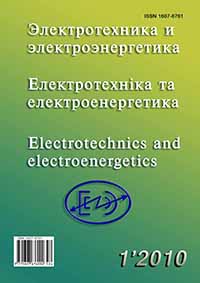Compound filter-compensating arrengement
DOI:
https://doi.org/10.15588/1607-6761-2010-1-12Keywords:
filter-compensating arrangement, night harmonics, losses of electrical energy, electric voltage, reactive powerAbstract
A new structure of a compound filter-compensating device is proposed. The developed filter advantages are: automatic variation of higher harmonics compensating parameters with minimal loss of electrical energy at reactive power transmission and electric voltage maintaining at a required level.References
Кущ В. В. Устройство ограничения дуговых перенапряжений в сетях 6–10 кВ промышленных предприятий / В. В. Кущ, А. И. Назаров, Д. В. Журавлев // Електротехніка та електроенергетика. –2005. –№ 1. –С. 82–85.
Іванов В. С. Режимы потребления и качество электроэнергии систем электроснабжения промышленных предприятий /В. С. Иванов, В. И. Соколов –М.: Энергоатомиздат, 1987. – 181 с.
ОвчаренкоА.С.Підвищенняефективностіелектро-постачання промислових підприємств /А. С. Овчаренко, Д. І. Розінський –К. : Техніка, 1989. – 224 с.
Пат. 20681, Україна, (51) МПК (2007) ho2J3/01. Комбінований фільтрокомпенсуючий пристрій / Журавльов Д. В, Кущ В. В., Назаров А. І.: Замовник та власник Запорізький національний технічний університет №U2006 06556, дата подання 13.06.2006, датапублікації 15.02.2007.Бюл. №2.
Downloads
How to Cite
Issue
Section
License
Copyright (c) 2017 V. V. Kushch, D. V. Zhuravljov, A. I. Nazarov, M. A. Fedotenko

This work is licensed under a Creative Commons Attribution 4.0 International License.
Creative Commons Licensing Notifications in the Copyright Notices
Authors who publish with this journal agree to the following terms:
Authors retain copyright and grant the journal right of first publication with the work simultaneously licensed under aCreative Commons Attribution License that allows others to share the work with an acknowledgement of the work's authorship and initial publication in this journal.
Authors are able to enter into separate, additional contractual arrangements for the non-exclusive distribution of the journal's published version of the work (e.g., post it to an institutional repository or publish it in a book), with an acknowledgement of its initial publication in this journal.
Authors are permitted and encouraged to post their work online (e.g., in institutional repositories or on their website) prior to and during the submission process, as it can lead to productive exchanges, as well as earlier and greater citation of published work.

